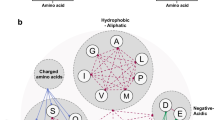Summary
-
1.
The neuroantibody approach, based on the expression of selected monoclonal antibodies by cells of the nervous system, has recently been described (Cattaneo and Neuberger, 1987; Piccioliet al., 1991). In order to apply this experimental strategy to study the role of nerve growth factor (NGF) in the central nervous system (CNS), we exploited the monoclonal antibody (mAb),αD11, which neutralizes very efficiently the biological activity of NGF, bothin vitro andin vivo (Cattaneoet al., 1988).
-
2.
TheαD11 antibody chains were cloned and expressed in COS cells as rat/human chimaeric proteins. The cloned antibody was shown to display all the properties of the parentalαD11 antibody, including its ability to neutralize NGF biological activity.
-
3.
This will allow us to engineer the expression of recombinantαD11 antibodies in the CNS, to study the role of NGF in the developing and adult nervous system. This approach can be extended to other neurotrophic factors for which neutralizing monoclonal antibodies are available.
Similar content being viewed by others
References
Berardi, N., Cattaneo, A., Cellerino, A., Domenici, L., Fagiolini, M., and Maffei, L. (1992). Monoclonal antibodies to NGF affect the postnatal development of the rat geniculocortical system.J. Physiol. 452:293P.
Bigon, E., Soranzo, C., Minozzi, C., Skaper, S. D., and Callegaro, L. (1990). Large scale purification and immunological characterization of human placental nerve growth factor.Neurochem. Res. 151197–1202.
Biocca, S., Neuberger, M., and Cattaneo, A. (1990). Expression and targeting of intracellular antibodies in mammalian cells.EMBO J. 9101–108.
Bocchini, V., and Angeletti, P. U. (1969). The nerve growth factor: purification as a 30,000 molecular weight protein.Proc. Natl. Acad. Sci. USA 64787–794.
Boshart, M., Weber, F., Jahn, G., Dorsch-Hasler, K., Fleckenstein, B., and Schaffner, W. (1985). A very strong enhancer is located upstream of an immediate early gene of human cytomegalovirus.Cell 41521–530.
Cattaneo, A., and Neuberger, M. S. (1987). Polymeric immunoglobulin M is secreted by transfectants of non-lymphoid cells in the absence of immunoglobulin J chain.Embo J. 62753–2758.
Cattaneo, A., Biocca, S., Nasi, S., and Calissano, P. (1983). Hidden receptors for NGF in PC12 cells.Eur. J. Biochem. 135285–290.
Cattaneo, A., Rapposelli, B., and Calissano, P. (1983). Three distinct types of monoclonal antibodies after long term immunization of rats with mouse NGF.J. Neurochem. 501003–1010.
Frohman, M. A., Dush, M. K., and Martin, G. (1988). Rapid production of full-length cDNAs from rare transcripts: Amplification using a single gene-specific oligonucleotide primer.Proc. Natl. Acad. Sci. USA 858998–9002 (1988).
Greene, L. A., and Tischler, A. S. (1976). Establishment of a noradrenergic clonal line of rat adrenal pheochromocytoma cells which respond to NGF.Proc. Natl. Acad. Sci. USA732424–2428.
Kabat, E. A., Wu, T. T., Reid-Miller, M., Perry, H. M., and Gottesman, K. S. (1987).Sequences of Proteins of Immunological Interest. U.S. Department of Health and Human Services, U.S. Government Printing Office, Washington, DC.
Levi-Montalcini, R. (1987). The nerve growth factor 30 years later.EMBO J. 61145–1154.
Levi-Montalcini, R., and Angeletti, P. U. (1966). Immunosympathectomy.Pharmacol. Rev. 18619–628.
Orlandi, R., Gussow, D. H., Jones, P. T., and Winter, G. (1989). Cloning of immunoglobulin variable domains for expression by the polymerase chain reaction.Proc. Natl. Acad. Sci. USA 863833–3837.
Piccioli, P., Ruberti, F., Biocca, S., Di Luzio, A., Werge, T. M., Bradbury, A., and Cattaneo, A. (1991). Neuroantibodies: Molecular cloning of a monoclonal antibody against substance P for expression in the central nervous system.Proc. Natl. Acad. Sci. USA 885611–5615.
Sambrook, J., Fritsch, E. F., and Maniatis, T. (1989).Molecular Cloning. A Laboratory Manual, Cold Spring Harbor Laboratory Press, Cold Spring Harbor, NY.
Thoenen, H. (1991). The changing scene of neurotrophic growth factors.Trends Neurosci. 14165–170.
Author information
Authors and Affiliations
Rights and permissions
About this article
Cite this article
Ruberti, F., Bradbury, A. & Cattaneo, A. Cloning and expression of an anti-nerve growth factor (NGF) antibody for studies using the neuroantibody approach. Cell Mol Neurobiol 13, 559–568 (1993). https://doi.org/10.1007/BF00711464
Received:
Accepted:
Issue Date:
DOI: https://doi.org/10.1007/BF00711464




